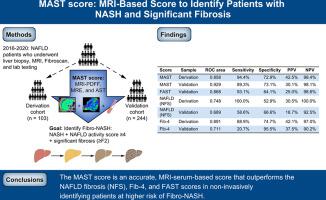Journal of Hepatology ( IF 26.8 ) Pub Date : 2021-11-17 , DOI: 10.1016/j.jhep.2021.11.012 Mazen Noureddin 1 , Emily Truong 2 , Jeffrey A Gornbein 3 , Rola Saouaf 4 , Maha Guindi 4 , Tsuyoshi Todo 5 , Nabil Noureddin 6 , Ju Dong Yang 1 , Stephen A Harrison 7 , Naim Alkhouri 8

|
Background & Aims
Among the large population of patients with non-alcoholic fatty liver disease (NAFLD), identifying those with fibrotic non-alcoholic steatohepatitis (Fibro-NASH) is a clinical priority, as these patients are at the highest risk of disease progression and will benefit most from pharmacologic treatment. MRI-based proton density fat fraction (MRI-PDFF) and MR elastography (MRE) can risk-stratify patients with NAFLD by assessing steatosis and fibrosis, respectively. We developed a highly specific MRI-based score to identify patients with Fibro-NASH.
Methods
This analysis included derivation (n = 103) and validation (n = 244) cohorts of patients who underwent MRI, liver biopsy, transient elastography, and laboratory testing for NAFLD from 2016-2020 in 2 tertiary care centers. To identify Fibro-NASH, a formula was developed based on MRI-PDFF, MRE, and a third variable with highest balanced accuracy per logistic regression. The MRI-aspartate aminotransferase (MAST) score was created and compared to NAFLD fibrosis (NFS), Fibrosis-4 (FIB-4), and FibroScan-aspartate aminotransferase (FAST) scores.
Results
The MAST score demonstrated high performance and discrimination in the validation cohort (AUC 0.93; 95% CI 0.88-0.97). In the validation cohorts, the 90% specificity cut-off of 0.242 corresponded to a sensitivity of 75.0%, positive predictive value (PPV) of 50.0% and negative predictive value (NPV) of 96.5%, whereas the 90% sensitivity cut-off of 0.165 corresponded to a specificity of 72.2%, PPV of 29.4%, and NPV of 98.1%. Compared to NFS and FIB-4, MAST resulted in fewer patients having indeterminate scores and an overall higher AUC. Compared to FAST, MAST exhibited a higher AUC and overall better discrimination.
Conclusion
The MAST score is an accurate, MRI-serum-based score that outperforms previous scores in non-invasively identifying patients at higher risk of Fibro-NASH.
Lay summary
Identifying patients with non-alcoholic steatohepatitis and significant fibrosis – who need treatment and are at risk of clinical liver-related outcomes – is a clinical priority. We developed a more accurate score using MRI-based technologies and a laboratory blood test (aspartate aminotransferase) that outperforms previous non-invasive scores for the identification of patients at higher risk of liver disease progression.
中文翻译:

基于 MRI (MAST) 的评分可准确识别患有 NASH 和显着纤维化的患者
背景与目标
在大量非酒精性脂肪性肝病 (NAFLD) 患者中,识别那些患有纤维化非酒精性脂肪性肝炎 (Fibro-NASH) 的患者是临床重点,因为这些患者疾病进展的风险最高,并且受益最多从药物治疗。基于 MRI 的质子密度脂肪分数 (MRI-PDFF) 和 MR 弹性成像 (MRE) 可以通过分别评估脂肪变性和纤维化对 NAFLD 患者进行风险分层。我们开发了一种高度特异性的基于 MRI 的评分来识别 Fibro-NASH 患者。
方法
该分析包括推导 (n = 103) 和验证 (n = 244) 队列,这些患者在 2016-2020 年期间在 2 个三级医疗中心接受了 MRI、肝活检、瞬时弹性成像和 NAFLD 实验室检测。为了识别 Fibro-NASH,基于 MRI-PDFF、MRE 和第三个变量开发了一个公式,每个逻辑回归具有最高的平衡精度。创建 MRI-天冬氨酸氨基转移酶 (MAST) 评分并将其与 NAFLD 纤维化 (NFS)、Fibrosis-4 (FIB-4) 和 FibroScan-天冬氨酸氨基转移酶 (FAST) 评分进行比较。
结果
MAST 评分在验证队列中表现出高绩效和歧视性(AUC 0.93;95% CI 0.88-0.97)。在验证队列中,0.242 的 90% 特异性临界值对应于 75.0% 的敏感性、50.0% 的阳性预测值 (PPV) 和 96.5% 的阴性预测值 (NPV),而 90% 的敏感性临界值0.165 对应于 72.2% 的特异性、29.4% 的 PPV 和 98.1% 的 NPV。与 NFS 和 FIB-4 相比,MAST 导致具有不确定分数和总体更高 AUC 的患者更少。与 FAST 相比,MAST 表现出更高的 AUC 和整体更好的辨别力。
结论
MAST 评分是一种准确的、基于 MRI 血清的评分,在非侵入性识别高风险 Fibro-NASH 患者方面优于以前的评分。
总结
识别患有非酒精性脂肪性肝炎和显着纤维化的患者——他们需要治疗并且有临床肝脏相关结果的风险——是临床优先事项。我们使用基于 MRI 的技术和实验室血液测试(天冬氨酸氨基转移酶)开发了一个更准确的评分,该评分优于以前的非侵入性评分,用于识别肝病进展风险较高的患者。











































 京公网安备 11010802027423号
京公网安备 11010802027423号